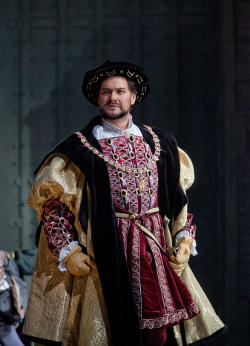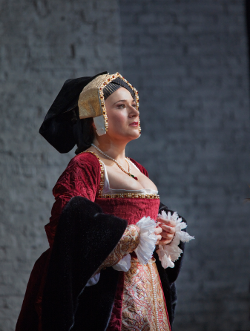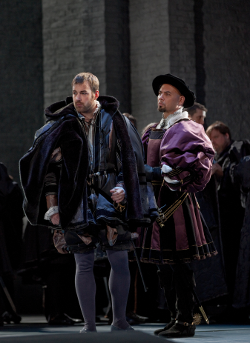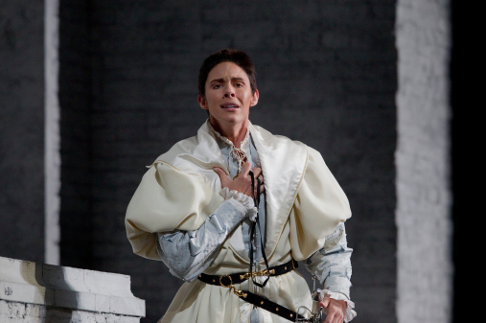01 Nov 2011
Anna Bolena, Metropolitan Opera
It’s very unusual for the Met these days—or any major opera house, in any era—to present a glossy new production with two different stars in the leading role.

It’s very unusual for the Met these days—or any major opera house, in any era—to present a glossy new production with two different stars in the leading role.
Giving seven performances of Donizetti’s Anna Bolena, in its first Met outing, with internationally glamorous Anna Netrebko followed by three more (not just one or two!) with a very different singer, rising bel canto star Angela Meade, a local girl with a large local following, has been a very happy choice. For one thing, this is a huge role in a little-known opera; it was insurance for the house to have a cover available, and any soprano capable of singing it well deserves a few chances to show what she can do. I’d heard what Netrebko’s version on the air from Vienna last spring, then by way of the Met web site’s free player on opening night here, and again by way of the HDTV movie theater showing at the BAMRose cinema in Brooklyn. On October 24, I attended Meade’s second Bolena in the house.
 Ildar Abdrazakov as Enrico
Ildar Abdrazakov as Enrico
Anna Bolena is perhaps the longest prima donna role in any of Donizetti’s operas—and Anna may be his longest work, fully four hours of music if uncut. It was his first hit in Milan (and, later, beyond the Alps), composed in 1830 after a busy decade in Naples, the capital of a different country at that time. He was determined to make an impression with a vehicle for Milan’s reigning singing actress, Giuditta Pasta. The role may lack the emotional spectrum of Bellini’s Norma, composed for the same singer a year later, but she had plenty to do: a double aria sortita, three highly charged duets (with mezzo, tenor and bass), a passionate trio, two full-scale ensembles, and a famous mad scene that ranges elaborately from pathos to rage. Canary coloraturas—this is not for you.
Overheard all about me in the crowd at the Met and at BAM: “This is such a wonderful opera! With such lovely music! Why has the Met never done it before?” If beautiful music and thrilling vocal drama were all that mattered, the Met has only scraped the surface of the nineteenth century’s possibilities, to say nothing of the eighteenth. In part, it’s a matter of fashion. By the time the Met was built, in 1883, dramatic coloratura vehicles were largely a thing of the past. Of Donizetti’s dozens of successful serious operas, only Lucia survived the stylistic change wrought by Verdi and his successors. Callas brought Anna Bolena back from a century’s obscurity in 1957, but she didn’t sing it often, bequeathing the La Scala production to Leyla Gencer. Caballé sang it just once, and acknowledged a rare failure. Sutherland did not tackle it till she was fifty-seven, far too late to make much of the character. Souliotis recorded it, unevenly as usual, but the recording has its partisans. Sills was New York’s Anna: she triumphed in it for a couple of seasons at the City Opera. Krassimira Stoyanova sang Bolena in a drastically cut concert version with Eve Queler’s Opera Orchestra of New York, and was spectacular in the raging fioritura of the “Giudici” scene—the opera came to life for me then as it never had before. She has not sung it anywhere since, perhaps because she lacks secure high notes: Anna ranges all over the scale. You might say she sings her head off.
 Ekaterina Gubanova as Giovanna Seymour
Ekaterina Gubanova as Giovanna Seymour
Everyone remembers that Henry VIII wished to be rid of his first wife, Catherine of Aragon, who had not borne him a son, and that the pope’s unwillingness to grant an annulment drove Henry, an opponent of Luther’s Reformation, to renounce papal supremacy. His passion for Anne Boleyn, which was quite genuine (their love letters have been set to music), was at first incidental to his wish to marry anyone capable of giving him a male heir, but Anne, in addition, was part of the clique forwarding Protestant reform. She was a highly attractive, sharp-tongued, neurotic femme fatale, capable of inspiring both passion and hatred, and when her sons, like Catherine’s, did not live (her daughter Elizabeth, of course, did), Henry turned against her brutally. She was accused of assorted adulteries (high treason for a queen), and sent to the block, to her great surprise (no one had beheaded a queen before). That was in 1536. In Italy three centuries later no one gave a hang about Protestant disputes, and the opera boils down to a marriage gone bad and the trap laid by a brutal husband to catch his wife in flagrante duetto. That’s an easy story for any audience to grasp, as is the prima donna unjustly done to death.
Whether Anna ever really loved Henry and if she still does are questions never mentioned in the libretto; this deprives her of a necessary dimension of tragedy (if she did), or exculpates him (if she did not). Perhaps Donizetti felt he had enough plot to set without facing such a question.
David McVicar’s production is large and dark, as if one look at the five-story-high stage of the Met overwhelmed any sense of proportion. Getting the proper atmosphere should not require such “authenticity.” I missed the light touch Ming Cho Lee brought to the City Opera’s Tudor trilogy: A tapestry down from the flies, a central playing area, a grand fireplace, an occasional throne or dungeon chamber, and there we had it: Instant Tudor! At the Met, Robert Jones’s sets look like the drearier rooms in a manor of the period—not the ornate court rooms!—and they are two or three times too high. They are vaguely historical backdrops, but they lack the color of backdrops. Jenny Tiramani’s costumes, too, may well be in period—I do not challenge that they are—but surely not everyone wore black and gray at a brilliant Renaissance court. The chorus, homogenous enough in Donizetti anyway, becomes a singing wainscot. The hunting forest, too, is gray, and the triple-arched corridor of the last act is simple to the point of self-effacing. Only the appearance of the swordsman at the end, Anna’s fate, seems to attempt a visual coup, and the music ignores him, focused by this point entirely on Anna.
 Stephen Costello as Lord Percy and Keith Miller as Lord Rochefort
Stephen Costello as Lord Percy and Keith Miller as Lord Rochefort
Anna Netrebko has a large and beautiful voice and can be a most affecting actress, but her voice never seems as at home in Italian music as it did when she sang Russian roles like Ludmila and Natasha. In bel canto, she suffers from imperfect agility and a nasal delivery that does not breathe with the music. The greatest bel canto artists school themselves to breathe in exactly the phrases the composers wrote, so that the melody, ornamented or not, becomes a melodious kind of speech, a vernacular poetry. I suspect Russian singers are trained to breathe differently in their own ancient church-based tradition, and very few of them escape it when singing western music, however beautiful the instrument itself. This is my problem with Galina Vishnevskaya’s Puccini, Dmitri Hvorostovsky’s Verdi and Ekaterina Gubanova’s Donizetti. A few Russian divas, such as Olga Borodina and Ljuba Petrova, seem to have surmounted this awkwardness; Netrebko has not. Too, I find her affect too heavy for Bolena, and on the Opening Night broadcast she was under pitch for much of the long night. This may be attributed to the strenuous rehearsal process and first-night jitters: By the HDTV broadcast nearly three weeks later, she was on pitch throughout, her voice in charge and easily produced. She has always been a fine actress, and a queen in distress suits her very well. Though I enjoyed her Vienna broadcasts of Bellini’s Giulietta and Amina very much, as sheer, lovely sound, my personal preference would be to hear this sensuous instrument in a more rewarding vehicle, such as Puccini’s Manon Lescaut. That’s a role that rewards a heavy, beautiful voice, and when did we last hear such a soprano attempt it? She’d be glorious.
I have heard Angela Meade as Elvira in Verdi’s Ernani, Rossini’s Semiramide and Bellini’s Norma. The voice is sizable over an exceptional range, but she wields it prettily, with genuine trills, a lovely legato and soft but clear singing in the higher ranges that falls on the ear with special grace. She is a rather stout woman, neither a beauty nor a natural actress, but as Bolena, who must present her tormented emotions over nearly four hours, she displayed impressive theatrical skill. In Act I, she was regal and apprehensive, moving with a dignified posture; after her accusation and trial, she seemed a much older woman, aged and bent by the storm. Her madness was distracted and appealing. She did not imitate the glamorous Netrebko’s highly personal gestures and expressions (the reminiscent smile, the turn away from the audience for the final note), but made the role her own within the restrictions of an existing production and cast.
 Tamara Mumford as Smeton
Tamara Mumford as Smeton
As a singer, Meade takes a while to warm up. In the first act, she seemed rather to hover over the notes; there was no depth to them, and she seemed merely to touch the highest notes and drop them. By the lengthy duet with Stephen Costello’s Percy, however—Donizetti’s Act II, but the last scene of Act I at the Met, where the opera is given with just one intermission—and the great “Giudici” ensemble that follows, she had her musical feet on the floor. Her duet with Ekaterina Gubanova’s Jane Seymour brought the thrilling days of Sutherland and Horne to mind. As Meade demonstrated in Ernani, she knows how to preserve her resources through a long night. By the long concluding scene, she was in her element, tremendously affecting in the sweet singing of “Al dolce guidami,” and then, with a terrific drop to almost threatening depths that exploded in the anger of “Coppia iniqua,” her final denunciation, a dramatic coloratura at last. The soprano who cannot make this scene her own is not a proper Bolena; Netrebko, too, was fully in charge here.
Gubanova is a Russian mezzo in the grand tradition of Arkhipova and Obastzova, but the Met can’t seem to figure out what to do with her—or such others of the ilk as Diadkova and Smirnova, the latter miscast in Don Carlo. Gubanova is a superb Berlioz Didon (as she has demonstrated at Carnegie Hall under Gergiev) and a superb Gluck Clytemnestre (under Muti in Rome), but she has had some difficulty forcing herself into the molds called for at the Met. To be fair, she only took on the role of Jane Seymour when Elina Garanca, who sang it gorgeously in Vienna, pulled out due to pregnancy, and if her sortita and its ornaments were messy, her duets with King Henry (desperate) and Anna (poignant) had a happy intensity. Her voice mingles well with Meade’s. But I wish they’d stage something Russian for her to sink her palpable artistic teeth into—or Gluck’s Alceste.
Stephen Costello’s once light and liquid tenor is developing grit and strength. This may forfeit some of his airy elegance, but will position him for the forceful tenor roles of later Donizetti, Verdi and Puccini, the basic Italian repertory. He made a handsome, credible figure in the far from credible role of Lord Percy, Anna’s old boyfriend. Slim Tamara Mumford sang another of her plummy performances, with a freer command of line up top than usual, in the trouser role of the importunate minstrel, Smeton. Ildar Abdrazakov was formidable in the somewhat underwritten (no aria) role of King Henry. His dark bass must believably threaten each of the other characters in turn or the plot makes no sense. In the present instance, the quailing of cast and chorus before him was believable. Shaven-headed Keith Miller, such a treat as Zuniga in recent Carmens, was impressive as Anna’s hapless brother, Rochefort.
Marco Armiliato, whose conducting on opening night has been criticized, certainly did not make the score sound shorter than it is, but he was attentive to vocal line and Donizetti’s favorite “British” effect, dark strings underscored by horns, rang out threateningly, gothicly, throughout the night.
John Yohalem